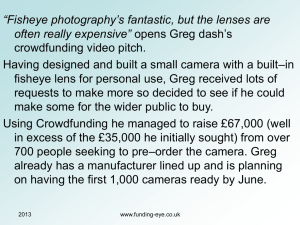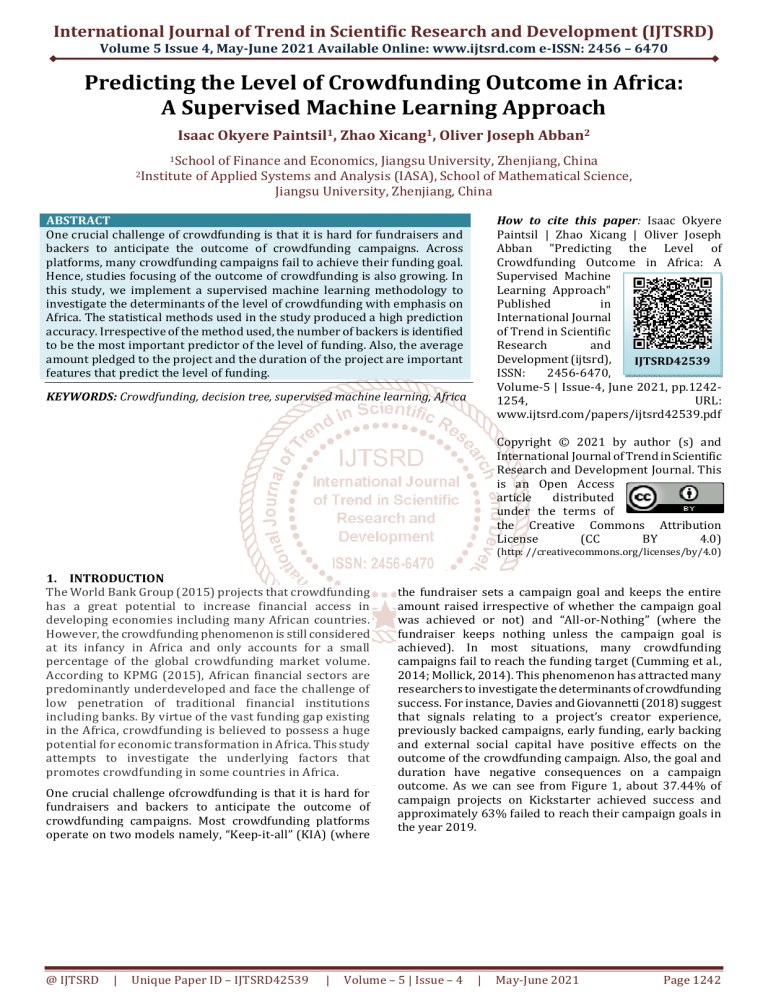
International Journal of Trend in Scientific Research and Development (IJTSRD)
Volume 5 Issue 4, May-June 2021 Available Online: www.ijtsrd.com e-ISSN: 2456 – 6470
Predicting the Level of Crowdfunding Outcome in Africa:
A Supervised Machine Learning Approach
Isaac Okyere Paintsil1, Zhao Xicang1, Oliver Joseph Abban2
1School
2Institute
of Finance and Economics, Jiangsu University, Zhenjiang, China
of Applied Systems and Analysis (IASA), School of Mathematical Science,
Jiangsu University, Zhenjiang, China
How to cite this paper: Isaac Okyere
Paintsil | Zhao Xicang | Oliver Joseph
Abban "Predicting the Level of
Crowdfunding Outcome in Africa: A
Supervised Machine
Learning Approach"
Published
in
International Journal
of Trend in Scientific
Research
and
Development (ijtsrd),
IJTSRD42539
ISSN:
2456-6470,
Volume-5 | Issue-4, June 2021, pp.12421254,
URL:
www.ijtsrd.com/papers/ijtsrd42539.pdf
ABSTRACT
One crucial challenge of crowdfunding is that it is hard for fundraisers and
backers to anticipate the outcome of crowdfunding campaigns. Across
platforms, many crowdfunding campaigns fail to achieve their funding goal.
Hence, studies focusing of the outcome of crowdfunding is also growing. In
this study, we implement a supervised machine learning methodology to
investigate the determinants of the level of crowdfunding with emphasis on
Africa. The statistical methods used in the study produced a high prediction
accuracy. Irrespective of the method used, the number of backers is identified
to be the most important predictor of the level of funding. Also, the average
amount pledged to the project and the duration of the project are important
features that predict the level of funding.
KEYWORDS: Crowdfunding, decision tree, supervised machine learning, Africa
Copyright © 2021 by author (s) and
International Journal of Trend in Scientific
Research and Development Journal. This
is an Open Access
article
distributed
under the terms of
the Creative Commons Attribution
License
(CC
BY
4.0)
(http: //creativecommons.org/licenses/by/4.0)
1. INTRODUCTION
The World Bank Group (2015) projects that crowdfunding
has a great potential to increase financial access in
developing economies including many African countries.
However, the crowdfunding phenomenon is still considered
at its infancy in Africa and only accounts for a small
percentage of the global crowdfunding market volume.
According to KPMG (2015), African financial sectors are
predominantly underdeveloped and face the challenge of
low penetration of traditional financial institutions
including banks. By virtue of the vast funding gap existing
in the Africa, crowdfunding is believed to possess a huge
potential for economic transformation in Africa. This study
attempts to investigate the underlying factors that
promotes crowdfunding in some countries in Africa.
One crucial challenge ofcrowdfunding is that it is hard for
fundraisers and backers to anticipate the outcome of
crowdfunding campaigns. Most crowdfunding platforms
operate on two models namely, “Keep-it-all” (KIA) (where
@ IJTSRD
|
Unique Paper ID – IJTSRD42539
|
the fundraiser sets a campaign goal and keeps the entire
amount raised irrespective of whether the campaign goal
was achieved or not) and “All-or-Nothing” (where the
fundraiser keeps nothing unless the campaign goal is
achieved). In most situations, many crowdfunding
campaigns fail to reach the funding target (Cumming et al.,
2014; Mollick, 2014). This phenomenon has attracted many
researchers to investigate the determinants of crowdfunding
success. For instance, Davies and Giovannetti (2018) suggest
that signals relating to a project’s creator experience,
previously backed campaigns, early funding, early backing
and external social capital have positive effects on the
outcome of the crowdfunding campaign. Also, the goal and
duration have negative consequences on a campaign
outcome. As we can see from Figure 1, about 37.44% of
campaign projects on Kickstarter achieved success and
approximately 63% failed to reach their campaign goals in
the year 2019.
Volume – 5 | Issue – 4
|
May-June 2021
Page 1242
International Journal of Trend in Scientific Research and Development (IJTSRD) @ www.ijtsrd.com eISSN: 2456-6470
% of Successfully funded Projects (2019)
Pe rcenta ge
62.56%
37.44%
Successful
Unsuccessful
State
Figure 1Kickstarter % of successfully funded projects in 2019 Source: Statista
2. Literature review
Zheng et al., (2014) argue that successful crowdfunding also
depends on what is valued by capital providers. Cholakova
and Clarysse (2015) report that the motivation for capital
providers to contribute towards crowdfunding is divers
including rewards and financial returns, help other people in
need and support a cause, and to form relationships and be
part of a community (Galuszka & Brzozowska, 2017; Gerber
& Hui, 2014; Lam & Law, 2016). Ryu and Kim )2015) classify
six incentives that motivates capital providers namely:
interest, playfulness, philanthropy, reward, relationship, and
recognition. They also identify four categories of
crowdfunding sponsors, namely, the angelic backer who
characterized by philanthropic motives, the reward hunter
who is characterized by reward motives, the avid fan who
characterized by several motives except rewards, and the
tasteful hermit who are similar to the avid fans but are less
driven by recognition and relationship motives). Choy and
Schlagwein (2016) also categorized crowdfunding capital
providers into four categories namely: the intrinsicindividual, the intrinsic-social, the extrinsic-individual, and
the extrinsic-social motivations. On another hand, Gerber
and Hui (2014) explain that distrust for a fundraiser’s
management of funds often discourages capital providers.
This situation is often associated with platforms where the
fundraiser full access to the funds even when the campaign
target has not been met.
Ciuchta et al., (2016) identify two categories of capital
providers namely, prevention-focused funders and
promotion focused funders. They argue that preventionfocused funders often look out for negative feedbacks
whereas promotion focused funders look out for positive
feedbacks to inform their contribution decisions.
Furthermore, promotion focused funders are more
responsive to social information in crowdfunding campaigns.
Burtch et al., (2013) explain that capital providers are often
inclined towards culturally similar and geographically
proximate fundraisers referred to as “home bias” by Lin and
Viswanathan (2016). By the same token, Mollick (2014)
suggest that geography plays an important role in the
success of crowdfunding campaigns, since a proportionately
@ IJTSRD
|
Unique Paper ID – IJTSRD42539
|
greater creative population in a fundraiser’s city is
associated with a greater probability of success. Agrawal et
al., (2015b) identify disparities in funding patterns between
local and distant capital providers. They argue that local
capital providers appear less responsive to information
about the cumulative funds raised by the fundraiser.
Galuszka and Brzozowska (2016) show that capital
providers are willing to support projects from friends and
local fundraisers.
Ordanini et al., (2011) stress that crowdfunding platforms
play different roles depending on the type of crowdfunding
they support. Platform design enables the capital providers
to grasp campaign messages (Choy & Schlagwein, 2016). The
policies and standards which guide the platform contribute
to determining the probability of success. For instance,
Farnel (2014), reveal that the Indiegogo’s guidelines and
standards were more welcoming to crowdfunding gender or
sexual reassignment surgery projects than Kickstarter and
YouCaring platforms. Yuan et al., (2016) explain that
platform cultures may are best comprehended by
performing a semantic analysis of campaigns on a platform
to uncover the topical features (i.e., latent semantics) of
successful campaigns. The availability of other projects on
the platform has an impact on the probability of success.
Meer (2014) and Parker (2014) explain that a handful of
good projects competing with a particular can cause the
project to be funded. Parker (2014) argue that not every
capital provider makes informed investment decision and
thus most capital providers tend to follow few informed
investors. Hence, capital providers tend to look out for other
people who often go back to contribute toward good
projects.
3. Supervised machine learning
Machine learning is a subfield of artificial intelligence that
learns patterns in data to perform specific tasks(Lopez de
Prado, 2018). The main classes of machine learning are
supervised machine learning, unsupervised machine
learning and reinforcement learning. In supervised machine
learning, computers learn from a labeled data to predict a
target variable. Supervised machine learning algorithms
Volume – 5 | Issue – 4
|
May-June 2021
Page 1243
International Journal of Trend in Scientific Research and Development (IJTSRD) @ www.ijtsrd.com eISSN: 2456-6470
basically perform two different types of tasks namely,
regression and classification.
Supervised machine learning approach is gaining popularity
for predicting crowdfunding outcome. Ren et al., (2018) uses
supervised machine learning methods to predict the daily
funding of crowdfunding projects. Similarly, Yu et al., (2018)
adopts supervised machine learning approach to predict the
success of a crowdfunding campaign. Ahmad et al.,
(2017)uses random forest model with optimally weighted
classifiers to predict crowdfunding success. Also, Chung and
Lee (2015)examine the impact of a project’s temporal
features to predict the range of pledges.
Algorithms explored in the study
3.1. Decision tree
Decision tree, introduced in the 1960’s is commonly used in
data mining for establishing classification systems based on
multiple covariates and for developing prediction algorithms
for a target variable (Ren et al., 2018). A Decision tree
analysis takes a graphical representation of diverse solutions
format. The process forms a flowchart structure made of
nodes, branches and leaves building blocks. These features
are explained as follows:
1. The root node which is the first node that decides the
entire sample space.
2. The splitting which are the branches that emanates from
the root node and also represents a set of decision
alternatives where one and only one decision can be
selected.
3. Internal nodes which represent the probability that an
outcome from the branch will occur.
4. Leaf representing the terminal node that predicts the
final outcome following a path from the root node.
Decision tree uses attributes that has the highest
information gain. The information gain is determined by
decrease in entropy after the data is split on an attribute.
Entropy is basically the measure of information. Below is a
mathematical representation of Entropy. The entropy
equation is as below:
1
where p is the data set, C is a dataset with classes and
represent the frequency of class i in the data set. The total
entropy for each split is computed and subtracted from the
entropy before the split to derive the information gain
represented in the equation below:
2
The attribute with the highest information gain becomes the
decision node for a repeated process to arrive at an entropy
of 0 which is also known as the leaf node.
We also explored some ensemble learning algorithms.
Ensemble learning in machine learning refers to an assembly
of models that learn a target function by training a number
of individual learners. Ensemble learning provides high
accuracy and efficiency using various methodologies
including bagging, boosting, and stacking.
3.2. Random forest
Breiman’s Random forest (Breiman, 2001) algorithm is an
ensemble of regression trees which develop easy to visualize
@ IJTSRD
|
Unique Paper ID – IJTSRD42539
|
decision rules for classification and regression. More
formally random forest can be expressed as:
3
where the function
and
is the sum of simple base models
is a simple decision tree. The Random forest
algorithm builds an ensemble of trees and each tree gives a
classification or class votes. Each tree within the random
forest model is trained from a random subset of data from a
training data set thus the randomness of the model is
implied. Random forest combines the output of multiple
decisions trees to arrive at a final output. The final output is
either determined by the averaging of the number of
decision trees or by the majority voting from each tree.
3.3. Extreme gradient boosting
Gradient boosting algorithm introduced by Tianqi Chen in
2014 is mostly used in machine learning are a result of the
need to improve upon weak classifiers and improve
prediction accuracy( see Chen et al., 2020). Boosting
technique is an ensemble approach the combines various
weak learners to build a high precision strong learner.
Boosting is also very useful for large data sets and also for
analysis that require high prediction accuracy. Furthermore,
boosting is extremely useful for classification, feature
selection, and multiclass categorization. extreme gradient
boost is characterized by high performance, speed and
scalable in nature. The algorithm can also handle parallel
processing and control for overfitting through its
regularization, sparsity awareness, weighted quantile sketch
and inbuilt cross validation.
4. Materials
The data for this study is taken from The Crowdfunding Data
Center. The Crowdfunding Data Center specializes in
tracking and providing information on various crowdfunding
campaigns from around the world. Data on crowdfunding
projects involving African countries that ended between 1st
September 2016 and 30th September 2016 are collected for
the analysis. Table1 displays countries, the number of
campaigns, and crowdfunding platforms for campaign
projects that ended within the period. Overall, 237
crowdfunding projects on Africa launched on
Kickstarter.com, Indeigogo.com, and Fundraiser.com are
reported within the study period. Kickstarter and Indiegogo
are among the leading non-equity-based crowdfunding
platforms globally (Steinberg 2012, Mollick 2015). Out of the
total number of crowdfunding projects in Africa sample, 11
projects were launched on Kickstarter.com platform
whereas 221 projects were launched on indeigogo.com and 5
projects were launched on fundrazrs.com. The steps
involved in launching a product includes a registration to
join the community which also involves providing personal
details to the platform providers. Then the fundraiser
receives the clearance to design and promote a webpage
with details of the crowdfunding project to attract the crowd
to make a decision to contribute towards the project or not.
Table 2 presents the structure of the data collected for the
study. The data includes the identification number, campaign
title, category, type of crowdfunding country, a link to the
campaign’s URL, launch date, end date, flexible fund,
fundraiser’s name, fundraiser’s email, social network sites,
project website, campaign target, the amount pledged, and
number of backers. The feature we incorporate in the study
include the availability of website (WBS), average amount
Volume – 5 | Issue – 4
|
May-June 2021
Page 1244
International Journal of Trend in Scientific Research and Development (IJTSRD) @ www.ijtsrd.com eISSN: 2456-6470
pledged to the project (AVP), and the availability of the
fundraiser’s personal information (INFO). For cognitive
social capital we include the type of crowdfunding (TYP) and
the funding duration (DRTN). With respect to structural
social capital, we incorporate the number of backers
(BKS)and social media account (SMC). The proposed model
takes the following structure.
Country
Benin
Botswana
Congo DRC
Cameroon
Cape Verde
Algeria
Egypt
Ethiopia
Ghana
Kenya
Liberia
Morocco
Madagascar
Mali
Mauritius
Malawi
Mozambique
Namibia
Niger
Nigeria
Rwanda
Senegal
Somalia
Tunisia
Tanzania
Uganda
South Africa
Zambia
Zimbabwe
Total
Variable
ID
Percentage funded
Date added
End Date
Category
Types
Platform
Link
Title
Country
Target
Number of backers
Average pledged
Creator’s name
@ IJTSRD
|
)
where FND is the crowdfunding campaign level of funding.
The analysis is conducted using R statistical software version
3.6.1 in an R studio version 1.2.1335 (R is a free statistical
software for computing and graphics).
Table 1List of countries sampled
No. of Projects Kickstarter Indeigogo
3
3
2
1
1
2
1
1
9
9
2
2
1
1
15
15
3
1
2
10
10
19
19
1
1
8
7
2
1
1
1
1
2
2
1
1
4
4
1
1
1
1
37
37
3
3
1
1
1
1
7
7
9
9
18
1
17
64
2
60
6
1
5
4
4
237
11
221
Fundrazr
1
1
1
2
5
Table 2Selected attributes from The Crowdfunding Data Center.
Description
Project index number
Percentage of funding target raised over the campaign
The date a specific crowdfunding campaign was launched.
The date a crowdfunding project was closed on the platform.
Animals, Arts, Comics, Community, Dance, Design, Education, Environment,
Fashion, Film, Food, Gaming, Health, Music, Photography, Politics, Religion,
Small business, Sports, Technology, Theater, Transmedia, Video, Writing.
The type of crowdfunding
The name of the crowdfunding platform
Link to information on the crowdfunding campaign
The title for a specific crowdfunding project.
The host country of the crowdfunding project
Amount of money the fundraiser targets.
Number of projects backed by creator.
Average amount of money pledged over time.
The name of the crowdfunding fundraiser
Unique Paper ID – IJTSRD42539
|
Volume – 5 | Issue – 4
|
May-June 2021
Data Type
Letters and numbers
Numbers
Date
Text
Text
Text
Text
Text
Currency
Number
Number
Text
Page 1245
International Journal of Trend in Scientific Research and Development (IJTSRD) @ www.ijtsrd.com eISSN: 2456-6470
Flexible fund
Website
Twitter account
Facebook account
Youtube account
The option to receive funding amount even if funding target is not reached.
Availability of project website
Fundraiser or project Twitter account.
Fundraiser or project Facebook account.
Fundraiser or project Youtube account.
Text
Text
Text
Text
5. Method
Figure 2 gives a depiction of the generic set of steps that would be followed.
Figure 2Structural design of the research
5.1. Study design and data collection
The first step in the research after problem analysis is to determine what kind of data is appropriate for the research objectives
and how much data is needed. The researcher must decide whether to use primary data or historical data and also choose the
appropriate data collection strategy. In the context of cost, time, and paucity of data, this study collects historical data through
existing statistics from various secondary sources. Advantages of using historical data collection for statistical analysis include
low measurement error, availability of variables longitudinally or cross-sectionally, and the potential for replication (Vartanian,
2011). With respect to the design of the study, the current study adopts factorial designs whereby we focus on prediction in
terms of finding the factors that affect the response variable.
5.2. Data pre-processing and exploratory data analysis
Data pre-processing refers to the addition, deletion, and transformation of data for the analysis. Data pre-processing is
necessary to prepare the data to the type usable by the predictive or explanatory model. Also, pre-procession is necessary to
take care of skewness and outliers in order to ensure high performance of the model. In particular, the most straightforward
data transformation is centering and scaling which ensures that all the variables have zero means. In this study we shall
consider the following data preprocessing objectives:
1. Omission of missing values: In the case of this study, we shall simply omit missing data values.
2. Data splitting: Data splitting is conducted to ensure that the models are useful for future instances. The first part of the split
which makes about 70% to 80% proportion of the original data set and it is used to train the model for internal validation.
The remaining proportion of the data serves as unseen data by the predictive model to use for the external validation. The
simplest way to split data in machine learning is by taking a stratified random sampling from the data.
Exploratory data analysis (EDA) is a vital preliminary step in statistical modeling. EDA procedures could include summarizing
the data numerically and graphically, reducing dimensionality, and a preparation for formal modeling. In statistical modeling
EDA is applied without any strict rules that must be followed. Thus, each form of EDA method should only aim at assisting the
purpose of capturing relationships that are possibly unknown or less formally expressed.
5.3. Model development
With predictive modeling the main priority is generating accurate predictions of new observations. Typically, there are single
model-based algorithms to perform both explanatory and predictive tasks; however, ensemble algorithms are mainly utilized
for predictive modeling. Most of these algorithms have their underlying statistical software packages with tunable parameters
that influence the way the algorithms perform depending upon the data sets. The choice of an algorithm and a package also
depends on the researcher’s experience and the classification or regression approach.
5.4. Cross validation
Cross validation engages resampling techniques to conduct a multiple repetition of data resampling to produce an aggregated
result using the training data. Cross validation is often used to tune model parameters to address the problem of overfitting for
both predictive and explanatory modeling. Furthermore, cross-validation evaluation is important and efficient than just
@ IJTSRD
|
Unique Paper ID – IJTSRD42539
|
Volume – 5 | Issue – 4
|
May-June 2021
Page 1246
International Journal of Trend in Scientific Research and Development (IJTSRD) @ www.ijtsrd.com eISSN: 2456-6470
observing the residuals of the model. This is because residual examination does not tell us how the model would perform on a
data it has not already seen whereas the main purpose of cross validation is to provide an estimate for the performance of the
model on a new data. There are several methods for choosing the portions of the sample to be used as a training and validation
sets for cross-validation. The cross-validation technique used in this study is the repeated k-fold cross-validation. The reason
for choosing the repeated k-fold cross-validation method is that the approach is less prone to selection bias and allows the
training data set to be further randomly divided into k disjoint sets of equal size n/k, where n is the features in the data set. For
each k= 1,2,⋯,K the cross-validation method fit the model with parameter to the other
parts and computes it error in
the prediction of the kth part. The process is repeated for many values of and selects value that makes the cross-validation
(λ)smallest.
5.5. Model evaluation
We adopt a confusion matrix approach to evaluate the models. A Confusion matrix is the performance matrix used in the
classification to determine the various performance related error types. We used the accuracy parameter of the confusion
matrix to determine the classification efficiency of the models in this study.
5.6. Prediction
Ideally, prediction in supervised machine learning is conducted using the testing data to ensure that the model’s performance is
evaluated with samples that were not used to train the model in order to ensure that an unbiased sense of the model
performance is ascertained.
5.7. Feature selection
Feature selection is integral to the predictive model to select the minimum required features to produce a valid model based on
the training set. Feature importance gives the score of each feature toward the output variable in the model.
6. Results
Table 3 presents the data preprocessing and the frequency of both the response variables and the predictors. We can observe
that 210 projects recorded a funding level that is between 0% to 20%, 12 projects recorded a funding level between 21% to
40%, 2 projects recorded a funding level between 41% to 60%, 3 projects recorded a funding level between 61% to 80%, 6
projects recorded a funding level between 81% to 100%, and 4 projects recorded a funding level above 101%. Also, with
respect to the type of crowdfunding, 3 projects are donation-based crowdfunding, and 234 projects are rewards based
crowdfunding projects. Similarly, 3 projects did not have the fundraiser’s information and 234 projects produced the
fundraiser’s information with respect to the availability of websites, 226 projects did not have websites whereas 11 projects
had websites. Again 191 projects where not publicized on social media whereas 46 projects were on social media.
Table 4 present the summary statistics of the numerical variables in the study. We can notice that the lowest duration for a
project is one day and the maximum is 212 days. Also, the minimum number of backers for a project is zero whereas the
maximum is 276. The mean average amount pledged is $27.16 and the maximum amount is $512.50.
Table 3
Preprocessing Value
Variable
Response
Percentage of funding
0 – 20
21 – 40
41 – 60
61 – 80
81 – 100
101+
Predictors
Type of crowdfunding
Donation
Rewards
Fundraiser’s information
No
Yes
Website
No
Yes
Social Media
No
Yes
FND
0
1
2
3
4
5
210
12
2
3
6
4
0
1
3
234
0
1
3
234
0
1
226
11
0
1
191
46
TYP
INFO
WBS
SCM
Table 4
Minimum Median
Predictors
Duration
Backers
@ IJTSRD
|
DRTN
BKS
Unique Paper ID – IJTSRD42539
Frequency
1
0
|
55
0
Volume – 5 | Issue – 4
Mean
Maximum
44
6
212
276
|
May-June 2021
Page 1247
International Journal of Trend in Scientific Research and Development (IJTSRD) @ www.ijtsrd.com eISSN: 2456-6470
Average pledge
1.0
AVP
0
1.6
0
0
150
27.16
1.0
512.50
1.6
1.0
1.6
0.18
0.58
0.32
−0.12
0.24
0.19
−0.45
−0.07
−0.05
−0.01
0.02
0.06
0.00
−0.06
0.10
−0.04
−0.02
0.20
−0.02
0.14
0.21
0.02
0.13
0.18
0.02
0.06
1
−0.36
4
FND
0
DRTN
150
1 .0
1 .8
TYP
0
AVP
400
0
200
BKS
WBS
1 .0
0.25
1 .8
1 .0
1 .8
INFO
1 .0
1 .8
SCM
1 3 5
0 100
0 200 500
Figure 3 Correlation plot
1.0
1.6
Figure 3 presents the scatter plot of matrices for the variables used in the study. The lower off-diagonal shows the scatter plot,
a regression line for a given pair of variables, and a diagonal histogram of each variable whereas the upper of diagonal shows
the pairwise Pearson correlation. We can observe that the level of funding has strong correlation with the number of backers,
giving us a first indication that the number of backers have a strong relationship with the level of funding.
6.1.
Decision tree
@ IJTSRD
|
Unique Paper ID – IJTSRD42539
|
Volume – 5 | Issue – 4
|
May-June 2021
Page 1248
International Journal of Trend in Scientific Research and Development (IJTSRD) @ www.ijtsrd.com eISSN: 2456-6470
1
BKS
p < 0.001
≤ 22
> 22
2
BKS
p < 0.001
≤8
>8
3
BKS
p < 0.001
≤4
Node 4 (n = 140)
1
0.8
0.6
0.4
0.2
0
012345
>4
Node 5 (n = 11)
1
0.8
0.6
0.4
0.2
0
012345
Node 6 (n = 9)
1
0.8
0.6
0.4
0.2
0
012345
Node 7 (n = 19)
1
0.8
0.6
0.4
0.2
0
012345
Figure 4 Decision tree diagram
Figure 4 shows the diagram for the decision tree classification model. It can be noticed that the number of backers for a given
project (BKS) forms the root node of the representing the most important variable in the model. We can observe that there is
99% confidence level that funding for projects that have BKS>22 would be classified in node 7 where there is approximately
30% chance of realizing funding between 0 to 20%, Projects that have BKS 22 would be decided by the number of backers
that are 8 and below than 8 or above 8. Projects that have the number of backers > 8 are classified into node 6 where there is
approximately 60% chance of achieving funding level between 0 to 20% and approximately 40% probability of achieving
funding level between 21% to 40%. Projects that have the number of backers 8 are decided by the number of backers 4 or
> 4. Projects that have the number of backers > 4 are classified into node 5 where there is approximately 70% chance of
attaining funding level between 0 to 20% and 30% chance of achieving funding level between 21% to 40%. Projects that have
the number of backers 4 are classified into node 4 where there is a 100% chance of attaining funding between 0 to 20%
funding level.
Table 5Actual and Predicted Confusion Matrix (Training data set)
Predicted response category
0-20 21-40 41-60 61-80 81-100
0-20
158
9
2
3
3
21-40
0
0
0
0
0
41-60
0
0
0
0
0
Actual response category
61-80
0
0
0
0
0
81-100
0
0
0
0
0
100+
0
0
0
0
0
100+
4
0
0
0
0
0
Table 5 shows the classification matrix of the predictions based on the decision tree algorithm using the train data. It can be
noticed that the model made158 correct prediction and classification for actual projects that recorded 0% to 20% funding.
However, there was no correct classification for the rest of the categories. The overall classification accuracy is approximately
88.26% indicating a prediction of the model.
Table 6 Actual and Predicted Confusion Matrix (Testing data set)
Predicted response category
0-20 21-40 41-60 61-80 81-100
0-20
52
3
0
0
3
21-40
0
0
0
0
0
41-60
0
0
0
0
0
Actual response category
61-80
0
0
0
0
0
81-100
0
0
0
0
0
100+
0
0
0
0
0
100+
0
0
0
0
0
0
Table 6 shows the classification matrix of the predictions based on the decision tree algorithm using the test data. It can be
noticed that the model made 52 correct prediction and classification for actual projects that recorded 0% to 20% funding. The
overall classification accuracy is approximately 89.65% indicating a prediction of the model.
6.2.
Random Forest
@ IJTSRD
|
Unique Paper ID – IJTSRD42539
|
Volume – 5 | Issue – 4
|
May-June 2021
Page 1249
International Journal of Trend in Scientific Research and Development (IJTSRD) @ www.ijtsrd.com eISSN: 2456-6470
0
10
20
Frequency
30
40
No. of Nodes for the Trees
8
10
12
14
16
18
20
treesize(model1)
Figure 5Number of tree nodes
Figure 5 shows the optimum number of trees used in the random forest algorithm that produces the minimum out of bag (OOB)
error rate to ensure that the model does not overfit. The model uses 12 trees with a frequency of 50.
MDS plot using (1 − Random Forest Proximities)
0.50
93
96
137
34
20
80
33
151
161
104
42
51
12
0.25
108
MDS2 − 18.2%
58
0.00
74 39
35
121
101
77
107
110
85
92
9
90
52
113
7
13
122
55
136
6
133
44
152
147
112
155
83
153
106
129
48
27
145
16
170
157
134
47
105
31
100
41
32
116
72
167
154
78
150
97
98
168
76
126
68
59
94
71
36
56
164
174
82
75
24
166
49
149
162
57
144
159
86
64
45
146
11
91
23
29
139
148
54
176
84
14
142
5
17
4
118
114
18
177
19
10
171
138
130
87
81
50
62
125
124
117
89
1215
61
69
140
123
8
178
40
26
169
99
143
179
73
88
127
158
63
53
115
25
109
175 79
30
141
Status
28
65
128
37
172
131
38
21120
132
15670
119
3
67
95
66
103
−0.25
a
0
a
1
a
2
a
3
a
4
a
5
165
22
163
60
102 46
160
43 135111
173
−0.50
0.00
0.25
0.50
0.75
MDS1 − 45.5%
Figure 6: MDS plot
Figure 5 shows the multidimensional scaling (MDS) plot based on the proximity matrix of the random forest algorithm. The
MDS plot is similar to the principal component analysis (PCA) bi plot to show the proximities of observations based on twodimensional plot. Each point represents an observation and the between points can be used to identify subgroups of cases that
keep together in the trees and also outliers that remain alone in the terminal node. It can be observed that the x-axis (MDS 1)
accounts for 45.7% of the variations among the observations whiles the y-axis (MDS 2) accounts for 18.2% of the variations in
the observations.
Table 7 Actual and Predicted Confusion Matrix (Training data set)
Predicted response category
0-20 21-40 41-60 61-80 81-100
0-20
158
0
0
0
0
Actual response category 21-40
0
9
0
0
0
41-60
0
0
2
0
0
@ IJTSRD
|
Unique Paper ID – IJTSRD42539
|
Volume – 5 | Issue – 4
|
May-June 2021
100+
0
0
0
Page 1250
International Journal of Trend in Scientific Research and Development (IJTSRD) @ www.ijtsrd.com eISSN: 2456-6470
61-80
81-100
100+
0
0
0
0
0
0
0
0
0
3
0
0
0
3
0
0
1
4
Table 7 shows the classification matrix of the predictions based on the random forest algorithm using the training data. It can
be observed that the model predicted and made a correct classification of 158 projects that obtained 0% to 20% of the
campaign target. The model correctly predicted 9 projects that realized between 21% to 40% of the campaign target. The
model correctly predicted 2 project that received between 41% to 60% of the campaign target. Again, correctly predicted 3
project that realized between 61% to 80% of the campaign target. Also, correctly predicted 3 projects that realized between
81% to 100% of the campaign target. Furthermore, correctly predicted 4 projects that realized over 100% of the campaign
target. The overall classification accuracy based on the model using the test data is 100% indicating complete accuracy.
Table 8 Actual and Predicted Confusion Matrix (Testing data set)
Predicted response category
0-20 21-40 41-60 61-80 81-100
0-20
52
2
0
0
2
21-40
0
1
0
0
0
41-60
0
0
0
0
0
Actual response category
61-80
0
0
0
0
0
81-100
0
0
0
0
0
100+
0
0
0
0
1
100+
0
0
0
0
0
0
Table 8 displays the classification matrix of the predictions based on the random forest algorithm using the test data. We notice
that the model predicted and made a precise classification of 52 projects that obtained 0% to 20% of the campaign target. The
model correctly predicted 1 project that realized between 21% to 40% of the campaign target. The overall classification
accuracy based on the model using the test data is 91. 37% indicating high classification accuracy.
Table 9 Variable importance
Variable Mean decrease Gini
BKS
17.4
AVP
14.2
DRTN
5.42
WBS
1.16
SCM
0.487
INFO
0.359
TYP
0.164
Table 9 presents the variable importance according to mean decreasing Gini. We can notice that the number of backers is
ranked as the most important variable followed by the average amount pledged.
Variable Importance (Mean Decrease in Gini Index)
Variable Importance from Random Forest Fit
15
Variable Name
BKS
AVP
10
DRTN
WBS
SCM
INFO
5
TYP
0
BKS
AVP
DRTN
WBS
SCM
INFO
TYP
Attributes
Figure 7 Random forest variable importance
Figure 7 presents the feature importance of the model based on the mean decrease Gini. It can be observed that the number of
backers (BKS) have the highest value of approximately 17.4. We can also notice that the average pledged to the project (AVP)
and the duration of the campaign (DRTN) have high values of approximately 14.2 and 5.42 respectively. Further, the use of
website (WBS) has an index of 1.16, social media (SCM) has an index value of 0.487, provision of fundraiser’s information
(INFO) has an index of 0.359 and the type of crowdfunding (TYP) produced a value of 0.164.
@ IJTSRD
|
Unique Paper ID – IJTSRD42539
|
Volume – 5 | Issue – 4
|
May-June 2021
Page 1251
International Journal of Trend in Scientific Research and Development (IJTSRD) @ www.ijtsrd.com eISSN: 2456-6470
1.0
0.0
0.5
e$train_mlogloss
1.5
6.3. Extreme Gradient Boosting
Figure 8 shows the simulation processes of the repeated cross-validation logloss error for the extreme gradient boosting
algorithm where 7000 iterations are performed using both the train and test data. The 3058th iteration produced the minimum
logloss value of 0.150654 for train data and a minimum logloss value of 0.463064 for the test data.
0
1000
2000
3000
4000
5000
6000
7000
e$iter
Figure 8 Extreme gradient boosting simulation
Table 10 Actual and Predicted Confusion Matrix (Training data set)
Predicted response category
0-20 21-40 41-60 61-80 81-100 100+
0-20
158
0
0
0
0
0
21-40
0
9
0
0
0
0
41-60
0
0
2
0
0
0
Actual response category
61-80
0
0
0
2
0
0
81-100
0
0
0
0
3
0
100+
0
0
0
0
0
4
Table 10 shows the classification accuracy for the predictions made by the extreme gradient boosting algorithm. It can be
noticed that the model produced 158 correct predictions for actual funding between 0% to 20%, 9 correct predictions for
funding between 21% to 40%, 2 correct prediction for funding amount recorded between 41% to 60%, 2 correct classification
for funding between 61% to 80% of the campaign target, 3 correct classification for predictions of funding raise between 81%
to 100% of the campaign target and 4 correct classification for predictions of over 100% funds raised from the campaign. The
overall classification accuracy of the extreme gradient boosting algorithm for the train data is 100%.
Table 11 Actual and Predicted Confusion Matrix (Testing data set)
Predicted response category
0-20 21-40 61-80
0-20
48
1
1
Actual response category 21-40
2
2
1
100+
2
0
1
Table 11 shows the actual and the predicted values classification matrix for the test data. It can be noticed that there is 48
correct classification for predictions of funding between 0% to 20% of the campaign target, 2 correct classification for
predictions of funding between 21% to 40% of the campaign target, and 1 correct classification for predictions of funding
between 61% to 80% of the campaign target. The overall extreme gradient boosting algorithm classification accuracy for the
test data is 87.93%.
Feature
BKS
AVP
DRTN
SCM
WBS 1
Table 12 Variable importance
Gain
Cover
Frequency
0.459227361 0.539407385 0.35420003
0.378494255 0.340286404 0.40584817
0.151410339 0.102924857 0.20313001
0.007124189 0.009398867 0.02288778
0.003743856 0.007982487 0.01393401
Table 12 and Figure 9 presents the feature importance of the model on a scale of 0 to 1. It can be observed that the number of
backers has the highest feature value of approximately 0.334 in the model indicating that Structural Social Capital has the
highest incentive to contributors. It can also be observed that the average pledged to the project (AVP) and the duration of the
@ IJTSRD
|
Unique Paper ID – IJTSRD42539
|
Volume – 5 | Issue – 4
|
May-June 2021
Page 1252
International Journal of Trend in Scientific Research and Development (IJTSRD) @ www.ijtsrd.com eISSN: 2456-6470
campaign (DRTN) feature as important variables in the model with values 0.32 and 0.20 respectively showing that Cognitive
Social Capital influences funding decisions. Further, the platform used for the campaign (PLT) also offers the Relational Social
Capital incentive to contributors with an importance value of approximately 0.73. Also, social media (SCM) representing
Structural Social Capital has importance value of approximately 0.64 in the model.
BKS
AVP
DRTN
SCM1
WBS1
0.0
0.1
0.2
0.3
0.4
Figure 9 Variable importance
7. Conclusion
In this study we undertake a prediction modeling of the level
of crowdfunding outcome with focus on African
crowdfunding campaign. We observe that project attributes
play a useful role in predicting the outcome of crowdfunding
campaigns (Etter et al., 2014; Kamath and Kamat, 2016).
Classification modeling of the outcome of crowdfunding
campaigns has become an emerging research interest in
recent years (Quercia and Crowcroft, 2014). Based on social
capital theory, we conducted a supervised learning modeling
of crowdfunding campaign outcome using different
classifiers. Conducting classification of the level of funding
using the training data, the ordinal logistic regression model
produced a classification accuracy of 91.32%, the decision
tree algorithm produced a classification accuracy of 88.16%,
the random forest algorithm produced 100% classification
accuracy, and the extreme gradient boosting algorithm
produced100% classification accuracy. Thus, the ensemble
models used in the study generated perfect prediction
accuracies with the training data set. Using the testing data,
the ordinal logistic regression yielded a classification
accuracy of 87.5%, the decision tree algorithm produced a
classification accuracy of 89.70%, the random forest
algorithm generated a classification accuracy of 94.12%,
whereas the extreme gradient boosting recorded a
classification accuracy of 83.33%. Thus, the random forest
model earned the highest classification accuracy
performance.
References
[1] Agrawal, A., Catalini, C., & Goldfarb, A. (2015).
Crowdfunding: Geography, Social Networks, and the
Timing of Investment Decisions. Journal of Economics
& Management Strategy, 24(2), 253–274.
https://doi.org/10.1111/jems.12093
Analyzing the important variables from the classifiers,
irrespective of the model used, the number of backers is
ranked as the most important variable for determining the
level of funding for any given crowdfunding project. Also, the
average pledged to the project is ranked second to the
number of backers. The random forest algorithm and the
extreme gradient boosting chose the duration of a project as
the third most important variable in predicting the level of
funding. Thus, the top three important predictors of the level
of funding based on the study are the number of backers, the
average pledged to the project, and the duration of a project.
@ IJTSRD
|
Unique Paper ID – IJTSRD42539
|
[2]
Ahmad, F. S., Tyagi, D., & Kaur, S. (2017). Predicting
crowdfunding success with optimally weighted
random forests. 2017 International Conference on
Infocom Technologies and Unmanned Systems (Trends
and Future Directions) (ICTUS), 770–775.
https://doi.org/10.1109/ICTUS.2017.8286110
[3]
Breiman, L. (2001). Random Forests. Machine
Learning,
45(1),
5–32.
https://doi.org/10.1023/A:1010933404324
[4]
Burtch, G., Ghose, A., & Wattal, S. (2013). An Empirical
Examination of the Antecedents and Consequences of
Contribution Patterns in Crowd-Funded Markets.
Information Systems Research, 24(3), 499–519. JSTOR.
https://www.jstor.org/stable/42004279
[5]
Chen, T., He, T., Benesty, M., Khotilovich, V., Tang, Y.,
Cho, H., Chen, K., Mitchell, R., Cano, I., Zhou, T., Li, M.,
Xie, J., Lin, M., Geng, Y., Li, Y., & implementation), Xgb.
contributors (base Xgb. (2020). xgboost: Extreme
Gradient Boosting (1.0.0.2) [Computer software].
https://CRAN.R-project.org/package=xgboost
[6]
Cholakova, M., & Clarysse, B. (2015). Does the
Possibility to Make Equity Investments in
Crowdfunding Projects Crowd Out Reward–Based
Investments?: Entrepreneurship Theory and Practice.
https://doi.org/10.1111/etap.12139
[7]
Choy, K., & Schlagwein, D. (2016). Crowdsourcing for
a better world: On the relation between IT
affordances and donor motivations in charitable
crowdfunding. Information Technology & People,
Volume – 5 | Issue – 4
|
May-June 2021
Page 1253
International Journal of Trend in Scientific Research and Development (IJTSRD) @ www.ijtsrd.com eISSN: 2456-6470
[19]
Chung, J., & Lee, K. (2015). A Long-Term Study of a
Crowdfunding Platform: Predicting Project Success
and Fundraising Amount. Proceedings of the 26th ACM
Conference on Hypertext & Social Media, 211–220.
https://doi.org/10.1145/2700171.2791045
Meer, J. (2014). Effects of the price of charitable
giving: Evidence from an online crowdfunding
platform. Journal of Economic Behavior &
Organization,
103(C),
113–124.
https://ideas.repec.org/a/eee/jeborg/v103y2014icp
113-124.html
[20]
Ciuchta, M., Letwin, C., Stevenson, R., & McMahon, S.
(2016). Regulatory Focus and Information Cues in a
Crowdfunding Context. Applied Psychology, 65, n/an/a. https://doi.org/10.1111/apps.12063
Mollick, E. (2014). The Dynamics of Crowdfunding: An
Exploratory Study. Journal of Business Venturing, 29,
1–16.
https://doi.org/10.1016/j.jbusvent.2013.06.005
[21]
Cumming, D., Leboeuf, G., & Schwienbacher, A. (2014).
Crowdfunding Models: Keep-it-All vs. All-or-Nothing.
SSRN
Electronic
Journal.
https://doi.org/10.2139/ssrn.2447567
Ordanini, A., Miceli, L., Pizzetti, M., & Parasuraman, A.
(2011). Crowd-funding: Transforming customers into
investors through innovative service platforms.
Journal of Service Management, 22(4).
[22]
Parker, S. C. (2014). Crowdfunding, cascades and
informed investors. Economics Letters, 125(3), 432–
435. https://doi.org/10.1016/j.econlet.2014.10.001
[23]
Ren, X., Xu, L., Zhao, T., Zhu, C., Guo, J., & Chen, E.
(2018). Tracking and Forecasting Dynamics in
Crowdfunding: A Basis-Synthesis Approach. 2018
IEEE International Conference on Data Mining (ICDM),
1212–1217.
https://doi.org/10.1109/ICDM.2018.00161
[24]
Ryu, S., & Kim, Y.-G. (2015). A Typology of
Crowdfunding Sponsors: Birds of a Feather Flock
Together? (SSRN Scholarly Paper ID 2734097). Social
Science
Research
Network.
https://papers.ssrn.com/abstract=2734097
[25]
SONG, Y., & LU, Y. (2015). Decision tree methods:
Applications for classification and prediction.
Shanghai Archives of Psychiatry, 27(2), 130–135.
https://doi.org/10.11919/j.issn.1002-0829.215044
[26]
The World Bank Group. (2015). Crowdfunding in
Emerging Markets: Lessons from East African Startups.
The World Bank Group.
[27]
Vartanian, T. (2011). Secondary Data Analysis.
Secondary
Data
Analysis,
1–216.
https://doi.org/10.1093/acprof:oso/978019538881
7.001.0001
29(1), 221–247. https://doi.org/10.1108/ITP-092014-0215
[8]
[9]
[10]
[11]
[12]
[13]
[14]
[15]
[16]
[17]
[18]
Davies, W. E., & Giovannetti, E. (2018). Signalling
experience & reciprocity to temper asymmetric
information in crowdfunding evidence from 10,000
projects. Technological Forecasting and Social Change,
133(C),
118–131.
https://econpapers.repec.org/article/eeetefoso/v_3a
133_3ay_3a2018_3ai_3ac_3ap_3a118-131.htm
Farnel, M. (2014). Kickstarting trans*: The
crowdfunding of gender/sexual reassignment
surgeries:
New
Media
&
Society.
https://doi.org/10.1177/1461444814558911
Galuszka, P., & Brzozowska, B. (2017). Crowdfunding
and the democratization of the music market. Media,
Culture
&
Society,
39(6),
833–849.
https://doi.org/10.1177/0163443716674364
Gerber, E., & Hui, J. (2014). Crowdfunding:
Motivations and Deterrents for Participation. ACM
Transactions on Computer-Human Interaction, 20, 34–
32.
KPMG. (2015). Sector report: Banking in Africa 2015.
Johannesburg,
South
Africa:
KPMG.
http://www.kpmg.com/Africa/en/IssuesAndInsights
/Articles-Publications/GeneralIndustriesPublications/Pages/Banking-in-Africa2015.aspx.
[28]
Lam, P. T. I., & Law, A. O. K. (2016). Crowdfunding for
renewable and sustainable energy projects: An
exploratory case study approach. Renewable and
Sustainable Energy Reviews, 60(C), 11–20.
https://econpapers.repec.org/article/eeerensus/v_3a
[29]
60_3ay_3a2016_3ai_3ac_3ap_3a11-20.htm
Lin, M., & Viswanathan, S. (2016). Home Bias in Online
Investments: An Empirical Study of an Online
Crowdfunding Market. Management Science, 62(5),
1393–1414.
https://econpapers.repec.org/article/inmormnsc/v_
3a62_3ay_3a2016_3ai_3a5_3ap_3a1393-1414.htm
Lopez de Prado, M. (2018). Advances in Financial
Machine Learning (Chapter 1) (SSRN Scholarly Paper
ID 3104847). Social Science Research Network.
https://papers.ssrn.com/abstract=3104847
@ IJTSRD
|
Unique Paper ID – IJTSRD42539
|
[30]
Yu, P.-F., Huang, F., Yang, C., Liu, Y.-H., Li, Z., & Tsai, C.R. (2018). Prediction of Crowdfunding Project Success
with Deep Learning. 2018 IEEE 15th International
Conference on E-Business Engineering (ICEBE).
https://doi.org/10.1109/ICEBE.2018.00012
Yuan, H., Lau, R., & Xu, W. (2016). The determinants of
crowdfunding success: A semantic text analytics
approach.
Decision
Support
Systems,
91.
https://doi.org/10.1016/j.dss.2016.08.001
Zheng, H., Li, D., Wu, J., & Xu, Y. (2014). The role of
multidimensional social capital in crowdfunding: A
comparative study in China and US. Information &
Management,
51(4),
488–496.
https://doi.org/10.1016/j.im.2014.03.003
Volume – 5 | Issue – 4
|
May-June 2021
Page 1254


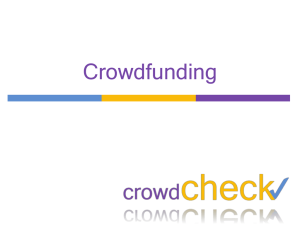
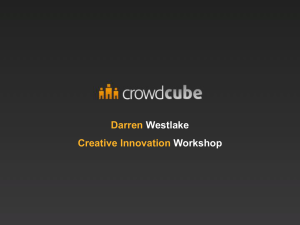
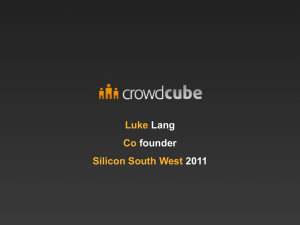

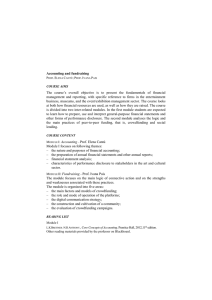
![[THIS SPACE MUST BE KEPT BLANK] Grassroots Innovation and Collaboration through Enterprise Crowdfunding](http://s2.studylib.net/store/data/013894189_1-14409bcbcdfd37c6e06f221441c5b4d1-300x300.png)
